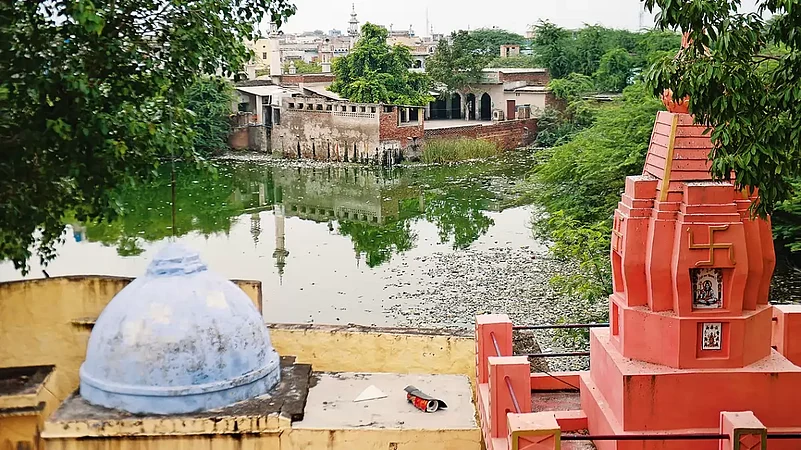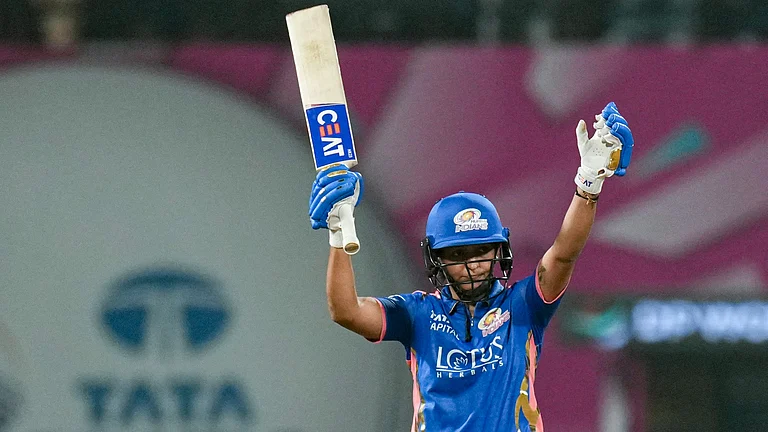On either side of a pond in Ghasera village in Haryana’s Nuh— home to a large population of Meo Muslims—rest a Shiva temple and a mosque. A stone’s throw away from here, in 1947, Mahatma Gandhi addressed thousands of Meo refugees from Alwar and Bharatpur in Rajasthan who were on their way to Pakistan and were staying at a camp in Ghasera. Calling them “India’s backbone”, Gandhi appealed to the Meos to not leave India. Weeks later, he was assassinated.
Decades have passed. The ground where Gandhi addressed Meos stands a government school—the only one in the village, unofficially named Gandhi Gram Ghasera. The village falls in the Mewat region—located about 64 km southwest of Delhi in the Alwar and Bharatpur districts of Rajasthan, and Nuh in Haryana. A NITI Aayog report identifies the region as the most backward in the country. Nuh, of course, made national headlines recently after episodes of communal clashes widened the divide between the Hindu and Muslim communities.
Weeks after the violence, there is an uneasy calm in Nuh. A frail Mohammd Shahdab Alam (name changed), 91, greets us with a salaam at his family home in Ghasera. When asked how old he was when Gandhi visited Ghasera in 1947, the old ‘master saab’ points at his teenage grandsons, Waseem and Suhail, and says that he had a similar build. The family has lived here for generations, but some members went to Pakistan during the partition. “We didn’t want to go, but we had properties in Lyallpur and my uncles left reluctantly. Baba (Gandhi) called us the backbone of India.”
Later, Prime Minister Jawaharlal Nehru brought back many Meos to India, who settled back in Mewat. According to the 2011 census and Population Data 2023 of Mewat, the total population of the district is a little over 10 lakh—Muslims constitute 79.2 per cent of the population. With a unique and also much-contested history, Mewat and Meos have been the emblem of the Ganga Jamuni Tehzeeb that India takes pride in.
However, post-partition, especially in the recent past, the Hindutva brand of politics has referred to Mewat as ‘mini-Pakistan’ and fabricated stories to instill fear, hate, and communal anxieties amongst the Hindu population in the region.
‘We Are One’

(Bordered by Delhi and Mathura on the one side and Agra and Bairat on the other, the beautiful stretches of a black mountain pass through its centre, whose beautiful ranges and ravines enhance the beauty of Mewat).
The Indo-Persian chronicles of the early Sultanate period categorised Meos as tribes who inhabited the vast stretches of Aravallis and dense forests of Mewat; notorious for cattle-lifting and plundering. With the passage of time, Meos adopted sedentary plough-based agriculture and transited towards the peasantry. Suraj Bhan Bhardwaj, in ‘Contestations and Accommodations: Mewat and Meos in Mughal India (2016)’ notes Abu Fazl’s observation in Ain-i-Akbari that the Mewat region was first brought under the Mughal administration during Akbar’s reign. Gradually, they emerged as the region’s landed elite by establishing their zamindari.
As Meos adopted agriculture as a means of sustenance, they were culturally and socially transformed from a tribal into a settled agricultural community. Like Hindus, they also received gotra identity and emerged as the dominant community in Mewat. It is argued that these tribal groups, now peasants, were also the oldest community of the region to be converted to Islam during the Sultanate period.

Alam says that Mewatis have fought the Mughals and the British alike. The community has fought alongside Hindu kings against Babur and other invaders. “We are Ramachandra’s children. That’s where we trace our bloodline. Our gotra-pals also match that of Hindus. The Mughals converted our great-great-grandfathers, but how do we become Hindus now? We were born to Islam. We like our religion.” Interestingly, the names of Alam’s great-grandfathers are Samay Singh, Ram Singh, Jyot Singh, Chand Singh, and so on.
To Alam, and many like him in Nuh, who have lived here for generations, the recent violence does not make any sense. “When we were little, we heard our elder Meos singing chaupayis during Holi. Our Muslim girls apply henna on girls in Hindu weddings. We have always been friends with our Hindu neighbours,” says Alam’s son Shehzad.
The Backward Transition
The economic significance of Mewat can be seen growing as Gurugram’s infrastructural stretch has now seeped into these villages. The 22-km Sohna Highway, which opened to commuters on July 11, 2022, now connects the city with the suburb within 15-20 minutes.
Investors, industry leaders, businesses and residents are optimistic, however, development continues to evade the reality of those living here. Only a small population in Nuh owns land. Most young men from the villages are working as labourers, auto drivers, daily wagers, construction workers or small shop owners in the Gurugram-Sohna-Delhi areas.
On the morning of August 2, Serajuddin (name changed), 57, offered us tea when we walked up to a group of Muslim men sipping their tea. They were sitting on their haunches on the desolate stretch from Gurugram to Nuh where Section 144 was imposed after communal violence broke out in the district on July 31, 2023, which spread across Haryana and Gurugram. Following the violence, only media and police personnel have been frequenting these roads that cut through Ghasera.

Md Shafin (name changed), 65, looked disgruntled as he pours tea for everyone. He rebuked, as his grandson, along with other kids, gathered around to see what was happening. Schools and Madrasas remained closed for over a week due to the curfew. When asked how far development has reached Ghasera, an annoyed Shafin ranted about the monthly expenses of water each family in the village incurs.
The villagers claim that the water is so saline that even buffaloes don’t drink it. “When we wash our face, our eyes burn so much that it fails soorma (kohl).” Although water pipelines were laid out over five years ago through these villages, they remain dry.
While Shafin was talking about the water woes, other men hushed him; they reminded him that water is not important. “Please restore peace in our villages that have been burning due to communal politics and hate. Our ancestors died drinking this water, yet this village has existed for generations. Don’t give us water; pour water on the fire that is taking away our harmony and brotherhood.”
For over a week past the violence, police have detained hundreds of Meo youths, minors included, from these villages. Four Rohingya refugees, including a 14 and 16-year-old, have also been detained from their camps in Nuh. The administration’s bulldozers have razed down over 500 houses and shops of Muslim residents. Instances of police brutality against those detained and arrested have also been reported by those detained and their families.
When Kanwar processions of thousands pass through the village, children from both communities dance to the tunes of the DJ. “This is the first time we have witnessed violence as such. It is incomprehensible,” claims Mukesh Sharma, 40. Mukesh, his brother Suresh and their families have been living close to the Shiva temple for generations. The two brothers share tales of how 150 Hindu families, surrounded by Muslim households, have been residing in the village in peace.
“On the evening of Nuh violence, our sarpanch held a meeting and assured us of safety. In 1992, when violence spread across the country following the Babri Masjid demolition, it was the elderly Muslims from our village who took responsibility for the safety of the temple,” says Suresh. On July 31, when violence broke out, it was a Muslim auto driver who dropped his son, 12, to safety when he was headed to the town for tuition.

Seeds of Islamophobia
“About 2,000 kanwariyas take this route each year. Some rest, some take refreshments, and some borrow beedis from us. Nothing inauspicious has ever happened during their processions,” says Salamuddin (name changed).
Locals claim only a few men from their villages participated in the recent Brij Mandal Yatra. “Most were outsiders from Jind, Karnal, Sonipat, Bhiwani, Ballabhgarh, Rohtak, Panipat, Faridabad and villages of Uttar Pradesh,” he says. Many Muslim families offer water to those participating in the procession.
Aash Mohammad, a security guard at the Nalhar Medical College, whose house was razed by the administration’s bulldozers, along with his son’s shops, recalls that during the Yatra, some devotees cooled themselves in the shed of his now-torn-apart courtyard and he offered them water.
The villages claim the seeds on the recent violence had been sown for years. The most recent instigation was videos of absconding cow vigilante and Vishva Hindu Parishad (VHP) affiliate Monu Manesar, and Hindutva affiliate Bittu Bajrangi. Following their videos, social media in the region was embroiled in tension with young boys from both communities engaging in cyber threats.
Attempts to deepen communal anxieties in the area are pre-organised, alleges Samay Singh, a Dalit ward member from Salambha village. He recounts a 2020 campaign that launched a series of baseless accusations against the Muslim community in Mewat and provoked Hindus. “Certain media channels spearheaded a narrative that Mewat has become a graveyard for Dalits and 103 Mewat villages had become ‘Hindu-less’. However, a fact-finding committee later found all these accusations to be untrue and part of a much larger Islamophobic narrative,” he says.
A Sarvajatiya Mahapanchayat was organised by a Hindu outfit in Palwal on August 13 where members demanded Nuh district be abolished. A 51-member committee decided that the region should be made cow slaughter-free. They also decided to resume the Yatra on August 28 from Nalhar in Nuh. The locals are wary. Another round of violence would widen the divide between two communities.
Alam claims that Hindus and Muslims have co-existed peacefully for decades, but it’s only after the BJP has come to power, faultlines have emerged. “Attempts have been made since the British Raj to drive Muslims away from India. Some political outfits are still indulging in these tactics. We are an integral part of this country. There is no Hindustan without Muslims,” he says.
(This appeared in the print as 'Widening Faultlines')

























